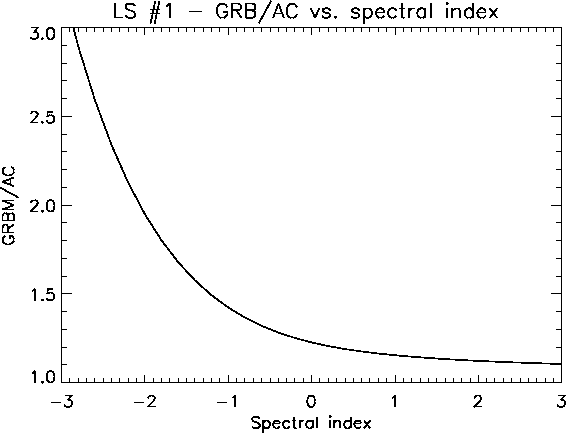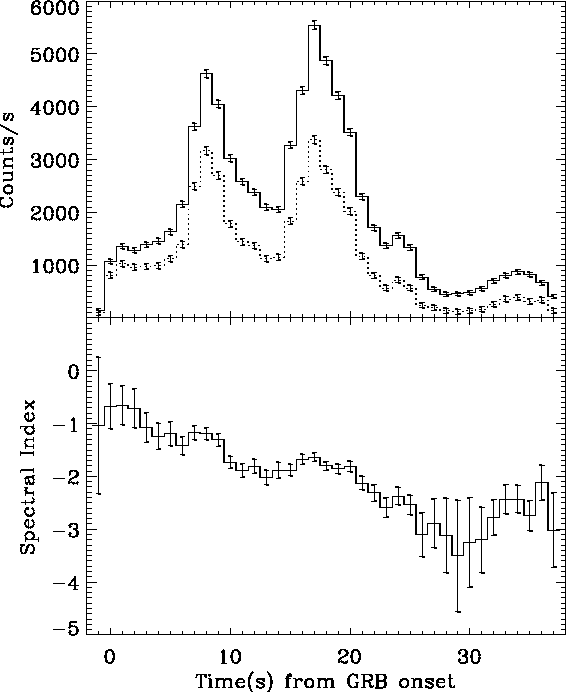 |
The ratio between counts in the GRBM and AC bands
depends on source direction and spectrum. Because, as we have discussed in chapter 3, these
data are equivalent to 2-channels spectra,
we must assume simple model spectra, like a single power-law (PL) or an
optically thin thermal bremsstrahlung (OTTB). Given the response in the
two ratemeters bands (chapter 3), i.e. the efficiency as a function of photon energy at the given source direction, the GRBM/AC counts
ratio is a function of the photon index (in case of PL) or temperature
(in case of OTTB). Off course, these functions do not depend on the incident spectrum normalization. Thus, to derive these relationship we have convolved spectra having different photon indexes or temperature values
with the detector response in the two ratemeters bands. In Fig. 4.7 we show the relationship between spectral index and counts ratio for LS1 and for on-axis source. Given the measured ratio, the spectral index or temperature is
then derived by means of a cubic spline interpolation.
 |
The normalization parameter of the spectrum can then be calculated by convolving an input spectrum of the extrapolated spectral index or temperature with the the responses of the GRBM detector in the entire energy band and comparing the measured counts to expected counts.
Background subtraction, for both the ratemeters
, is generally a safe procedure, due to stable background. Exceptions have
occurred, as for GRB970228 (Frontera et al., 1998) which occurred during the
above mentioned 'pre-SAGA' anomaly and required specific efforts to
extrapolate the background during the event. Generally, we interpolate the background in the
GRBM and AC ratemeters during the event with a polynomial fit to the data
before and after the event (about 150 s time intervals). After background subtraction,
ratemeters data are analyzed through software which applies the methods
described above to infer spectral index or temperature
evolution together with photon flux evolution. Data are usually grouped to obtain more statistics quality for weak
GRBs or to obtain average values in correspondence of the rise or fall of the pulses. It is important to note that with the
actual thresholds values the energy bounds are 40-700 keV for the GRBM band and > 100 for the AC band. Because of the low efficiency of the detectors above
700 keV and the general shape of GRB spectra, we make the assumption
that, except for the very first instants of some events, the source
contribution to the counts above 700 keV is negligible. Thus, the difference
between the counts in the GRBM and AC bands can be assumed to be almostly due
to photons leaving in the detector an energy between 40 and 100 keV.
Moreover, the 2 bands are overlapped in the region 100-700 keV, where
the data are completely co-variant. This is taken into account when estimating
the variance of the GRBM - AC (40-100 keV band) computed counts. In this computation we
introduce the variance of the background above 700 keV, which is estimated
by comparison of the AC average counts with the 240 channel spectra counts, from which it is possible to estimate the average 100-700 keV background contribution.
A typical result of GRBM spectral evolution analysis of a GRB obtained by
applying the above methods is shown in Fig. 4.8 for GRB970111 ([Amati, L. et al. 1999]),
One of the brightest events detected by the GRBM. The source were close to the
LS3 axis (![]() =12.4
=12.4![]() ,
,![]() =7.7
=7.7![]() ); the GRB position was derived with high accuracy from WFC data.
); the GRB position was derived with high accuracy from WFC data.
 |